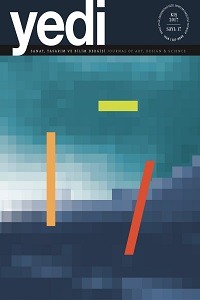Öz
Kökenleri, etkileri ve günümüze kadar geçen zaman için-deki gelişimine dair çok az sayıda akademik araştırma ya-pılmış olmasına rağmen Barbershop (kelimesi kelimesine çevrildiğinde, Türkçe’de berber dükkanı anlamına gelir) şarkı söyleme pratiği Abbott’un (1992: 289) deyimiyle “en büyük Amerikan icatlarından biridir”. Genel itibariyle vo-kal müzik ve müteakip akapella quartet grupları üzerinde derin etkiler bırakmış olan Barbershop müziği halen dünya çapında canlı bir biçimde icra edilmektedir. Bu inceleme barbershop şarkı söyleme pratiğinin müzikal öğeleri, genel karakteristikleri, kökleri ve gelişiminin tarihsel bir değer-lendirmesinden sonra Amerika Birleşik Devletleri’ndeki Barbershop Armonisi Derneğinin (Barbershop Harmony So-ciety ya da SPEBSQSA)1 ve özellikle popüler kültürün bu özgün şarkı söyleme stilinin korunma ve geliştirilmesinde-ki rollerini tartışmaktadır.
Anahtar Kelimeler
Kaynakça
- Abbott, Lynn (1992). “Play That Barber Shop Chord: A Case for the African-American Origin of Barbershop Harmony”, American Music 10(3): 289-325.
- Averill, Gage. (2000). Review of Robert A. Stebbins, The Barbershop Singer: Inside the Social World of a Musical Hobby (Toronto: University of Toronto Press., 1996), Ethnomusicology 44(2): 341-343.
- Ayling, Benjamin C. (2000). An Historical Perspective
- of International Champion Quartets of the Society for the Preservation and Encouragement of Barber
- Shop Quartet Singing in America, 1939-1963, Doctoral
- dissertation, The Ohio State University.
- (2004). “An Historical View of Barbershop Music and the Sight- Reading Methodology and Learning Practices of Early Championship Barbershop Quartet Singers, 1939-1963” International Journal of Research in Choral Singing 2(1): 53-59.
- Berry, Mark (2002). “Music, Postmodernizm,and George Rochberg’s Third String Quartet
- Lochhead”. Postmodern Music/Postmodern Thought, eds. Judith Irene Lochhead and Joseph Henry Auner. Studies in Contemporary Music and Culture, v. 4.
- New York: Routledge.
- Henry, James Earl (2000). The Origins of Barbershop Harmony: A study of Barbershop’s Musical Link to Other African American Musics as Evidenced Through Recordings and Arrangements of Early Black and White Quartets, Ph.D. dissertation, Washington University, Missouri.
- _____ (2005). “Barbershop Quartets.” In W. K. McNeil, ed., Encyclopedia of American Gospel Music, 24-27.
- New York: Routledge.
- Hicks, Val J. (1988). Heritage of Harmony. Kenosha, WI: SPEBSQSA, Inc. 10
- _____ “Barbershop” 2001. In Stanley Sadie, ed., The New Grove Dictionary of Opera. Grove Music Online. http://www.oxfordmusiconline.com (29.09. 2016).
- Lornell, Kip (2001). “One Hundred Years of Black Gospel Quartet Singing”. American Popular music: New Approaches to the Twentieth Century, eds. Rachel Rubin and Jeffrey Paul Melnick, Amherst, MA: University of Massachusetts Press, p: 141- 171.
- Stiffler, Matthew W. (2003). Harmony in four parts: Barbershop Music and Mormon Culture in Northern Utah, M.S. dissertation, Utah State University, Utah.
- Tagg, Philip (2006). “Music, Moving Images, Semiotics, and the Democratic Right to Know.” Music and Manipulation: On the Social Uses and Social Control of Music, eds. Brown, S., & Volgsten, U. 2006.
- New York: Berghahn Books. 163- 186.
Öz
Kaynakça
- Abbott, Lynn (1992). “Play That Barber Shop Chord: A Case for the African-American Origin of Barbershop Harmony”, American Music 10(3): 289-325.
- Averill, Gage. (2000). Review of Robert A. Stebbins, The Barbershop Singer: Inside the Social World of a Musical Hobby (Toronto: University of Toronto Press., 1996), Ethnomusicology 44(2): 341-343.
- Ayling, Benjamin C. (2000). An Historical Perspective
- of International Champion Quartets of the Society for the Preservation and Encouragement of Barber
- Shop Quartet Singing in America, 1939-1963, Doctoral
- dissertation, The Ohio State University.
- (2004). “An Historical View of Barbershop Music and the Sight- Reading Methodology and Learning Practices of Early Championship Barbershop Quartet Singers, 1939-1963” International Journal of Research in Choral Singing 2(1): 53-59.
- Berry, Mark (2002). “Music, Postmodernizm,and George Rochberg’s Third String Quartet
- Lochhead”. Postmodern Music/Postmodern Thought, eds. Judith Irene Lochhead and Joseph Henry Auner. Studies in Contemporary Music and Culture, v. 4.
- New York: Routledge.
- Henry, James Earl (2000). The Origins of Barbershop Harmony: A study of Barbershop’s Musical Link to Other African American Musics as Evidenced Through Recordings and Arrangements of Early Black and White Quartets, Ph.D. dissertation, Washington University, Missouri.
- _____ (2005). “Barbershop Quartets.” In W. K. McNeil, ed., Encyclopedia of American Gospel Music, 24-27.
- New York: Routledge.
- Hicks, Val J. (1988). Heritage of Harmony. Kenosha, WI: SPEBSQSA, Inc. 10
- _____ “Barbershop” 2001. In Stanley Sadie, ed., The New Grove Dictionary of Opera. Grove Music Online. http://www.oxfordmusiconline.com (29.09. 2016).
- Lornell, Kip (2001). “One Hundred Years of Black Gospel Quartet Singing”. American Popular music: New Approaches to the Twentieth Century, eds. Rachel Rubin and Jeffrey Paul Melnick, Amherst, MA: University of Massachusetts Press, p: 141- 171.
- Stiffler, Matthew W. (2003). Harmony in four parts: Barbershop Music and Mormon Culture in Northern Utah, M.S. dissertation, Utah State University, Utah.
- Tagg, Philip (2006). “Music, Moving Images, Semiotics, and the Democratic Right to Know.” Music and Manipulation: On the Social Uses and Social Control of Music, eds. Brown, S., & Volgsten, U. 2006.
- New York: Berghahn Books. 163- 186.
Ayrıntılar
| Bölüm | Sanat ve Edebiyat |
|---|---|
| Yazarlar | |
| Yayımlanma Tarihi | 27 Ocak 2017 |
| Gönderilme Tarihi | 27 Ocak 2017 |
| Kabul Tarihi | 27 Ocak 2017 |
| Yayımlandığı Sayı | Yıl 2017 Sayı: 17 |
This work is licensed under a Creative Commons Attribution 4.0 International License.

